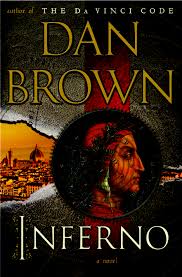 Packed with fun and craftiness, Dan Brown’s Inferno originally debut in 2013 and was well received overall by critics. Lost during the four hundred and eighty pages of Robert Langdon trotting through Italy though is any kind of deviation from the structured plot stringent to the tropes of the mystery and thriller genre. It makes everything extremely predictable. Inferno is not a loved or hated book but it’s so specifically mapped out in its stories and characters, which Brown also applies to his other novels, that it makes for a mediocre story with few punches but an ending that will knock you right in your polar vortex.
Packed with fun and craftiness, Dan Brown’s Inferno originally debut in 2013 and was well received overall by critics. Lost during the four hundred and eighty pages of Robert Langdon trotting through Italy though is any kind of deviation from the structured plot stringent to the tropes of the mystery and thriller genre. It makes everything extremely predictable. Inferno is not a loved or hated book but it’s so specifically mapped out in its stories and characters, which Brown also applies to his other novels, that it makes for a mediocre story with few punches but an ending that will knock you right in your polar vortex.
Robert Langdon wakes up in the hospital with no memory of the last few days. He’s in Italy with some kind of head wound. He meets the talented, resourceful (beautiful, of course) Sienna Brooks. Not long afterwards, they are running for their lives from a mysterious organization who seem to perceivably want Langdon dead. In the events that unfold, Langdon soon finds himself caught in the middle of a plot in which he must piece together clues to help not only prove his innocence but also save the population from a catastrophic engineered virus.
One of the book’s selling points is the references to Dante Alighieri’s Divine Comedy, which as you would expect, coincides with nearly every part of the story and also prompts us to try and solve the next clue. Here Langdon is in his element and where the story feels strongest and self-confident, but then the story begins to wobble; it tries too hard to misdirect us and undermines some of the novel’s setup and we’re suddenly in a different kind of story. There are no villains here, but apparently there are a number of heroes and dark knights. Everyone’s motive is quintessentially for the greater good, and although that thought is an interesting concept, Inferno simply pastes these ideas together without really exploring it.
And while the art references are certainly one of the highlights of novel, it’s also hinders it. The art exposition morphs into fodder towards the end. Langdon’s commentary on the art pieces, which he’s supposedly seen on more than one occasion, should be treated more like footnotes instead of being incorporated into the main story. They just don’t elevate the story or its characters–other than to reaffirm that Robert Langdon is an art historian and, yes, he loves art. I don’t know whether if he’s aplomb or if he’s just extremely desensitized by this point in the story. And let’s not forget to mention how Mr. Robert Langdon was disorientated from his initial ordeal; yet he seems to function just fine at solving the mystery, as if it’s just a game of cross-word puzzle to him. Granted he is a smart man, but it feels too convenient for him and too much of a stretch for me to jump on board Langdon’s art knowing wizardry. The idea itself is silly, but without it, the story would be less entertaining, which is the sole purpose of reading it considering the plot ends up being a wild goose chase.
Sienna Brooks, however, is an exceptional, strategic, and compassionate woman. It’s hard to believe she’s only sidekick material though. She possesses an incredible amount of tenacity and intellect that surpasses Langdon. Knowing her involvement in the story, it’s a surprise she’s downgraded mostly to a supportive role. Complicating this is Inferno’s conventional story and character growth. Boxed in by a formulaic plot, the character development is contained; hence, Sienna Brooks provides just enough smarts and conversation to move the story along.
Inferno wears you down eventually and you’re ultimately sucked into its absorbing plot in saving the world from a mad scientist bent on dealing with the overpopulation problem, which is possibly my favorite part. It ends up being more unexpected than you would think considering how everything is so neatly placed.
But Brown’s style of writing has its own problems, employing short chapters that end with ‘suspenseful’ cliffhangers. I’m well aware that this story is a mystery/thriller; yet I feel it’s disabling the writing and content. Most of these chapters are sprints. Anything significant is held for the very end and then wraps up at the beginning of the next chapter. This tactic is done in nearly every chapter and quickly loses its effect.
We also see this in some of Inferno’s miscellaneous characters. Although some are intriguing, it just doesn’t serve to highlight them, especially when their only purpose is to open the door for the two main characters to make their getaway. Just—why? To appreciate the Average Joe by reinforcing the notion that Average Joe can only do average things? Need I remind that buried in these pages is an ostensible threat to kill off most of the population?
A banal story, Inferno still serves its purpose in distracting our attention and leading us toward a conclusion, and it does so in the most entertaining way possible; however, there is little satiating substance that can be found in its story and characters. It’s a novel not worth taking too seriously but can pacify your boredom on a Sunday afternoon.
